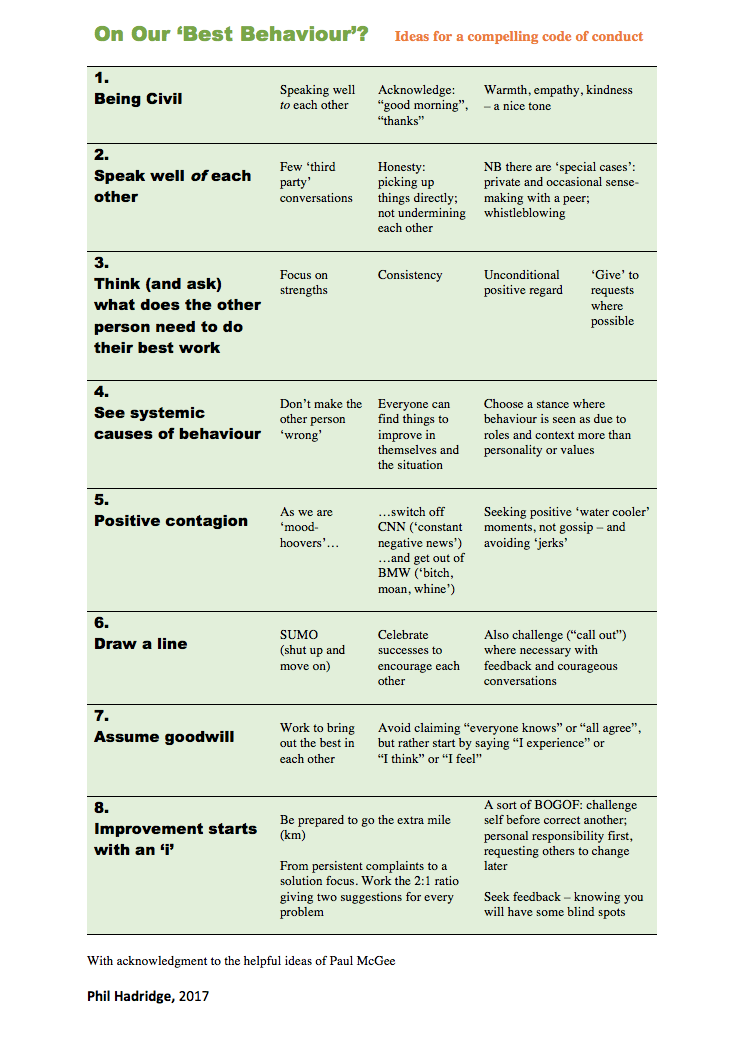
Satisfaction is a function of expectation. Many of us have very high aspirations for our organisations – to be places worthy of our fullest commitment. If this ambition is not achieved cynicism and frustration can fester. This is especially the case in ‘noble purpose’ organisations with intentions beyond simply making a profit.
This 8 point checklist shares ideas to improve the tone of an organisation. The ideas start with ‘organisational niceness’ with pro (rather than anti) social behaviours. It owes a debt to Paul McGee's SUMO philosophy (of ‘shut up and move on’) that extends to switching off CNN (constant negative news) and getting out of BMW (bitch, moan, whine).
Why is all this important? Because as humans we are ‘mood-hoovers’, soaking up the tone of what happens around us.
This list is drawn from my many years of working with a range of organisations struggling with issues including morale, engagement and continuous improvement. It captures suggestions to help groups get on to the ‘front foot’ and minimise unproductive friction. It builds on my research from the mid noughties on getting desired values into practice.
Together, along with group commitment and leadership action, these make for a series of helpful ‘nudges’. Small shifts of 10-20% in individual attitude and action can have a large cumulative effect as the collective impact adds up and becomes self-reinforcing.
This checklist is shared for possible adaption to become agreed team standards. Think: which behaviours will help you do your best work? Which might be easiest and which the hardest for you personally and your team?
"The standard you walk past is the standard you accept."
Lieutenant General David Morrison, when Australian Chief of Army

[Click to view full size image]
The idea of Example highlights the role of senior leaders and Boards in setting the cultural tone for an enterprise. Line leaders and other managers are key in re-iterating this. Peers reinforce or undermine the ‘right’ behaviours. Most of us are not saints or sinners, rather we absorb the ways others work. This starts with basic ‘pro-social’ interactions to do with decency and civility. It extends through to the modelling of important cultural characteristics like focus and responsibility.
'Example' is the mechanism that ingrains important attributes for successful organisations like curiosity and productive conflict.
Example is also concerned with making sure the implied attitudes at the core of a business’s purpose are actually demonstrated by staff, in both their dealings with each other as well as with customers. For example, do we witness 'caring' in all interactions in health service organisations? Is 'learning' seen everywhere in an education provider? What about 'speed' for a high street fashion brand? And do conservation organisations preserve their best characteristics, restore relationships when degraded and pursue ongoing evolution to be in harmony with their external environment?
There are lots of ‘tools’ to help you out there. They range from the simple to the hard; the straightforward to the wacky. Maybe research some, imagine some more and try a few out:
Do choose the behaviour most likely to help you, and others. All the best in becoming the co-worker you aspire to be.
Here's a great framework for a compelling "code of conduct" for a team or organisation. It's shared by @philhadridge for other teams to adapt. Which behaviours might help you & your team do your best work? https://t.co/zxQfLT3mWe pic.twitter.com/mOhnJsA14i
— Helen Bevan (@helenbevan) May 27, 2018
Sign up for updates on our latest thinking via the Business Briefing